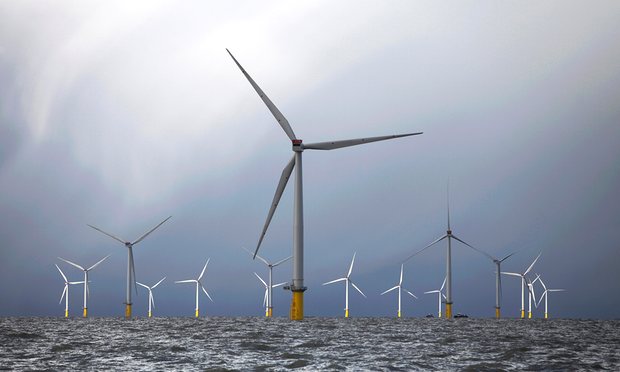A group of offshore wind companies have pledged that the technology will generate electricity as cheaply as fossil fuels in Europe within a decade – but only if policymakers across the EU take the steps needed to ensure such growth as a matter of urgency.
The pledge and the challenge to ministers are designed to reposition offshore wind as having a strong future in the EU. The European commission has tended to emphasise gas as the priority source of energy security.
The companies include the renewable energy arms of General Electric, Siemens, RWE, Iberdrola, Statoil and Vattenfall.

In an open letter, chiefs or senior executives from the 11 companies wrote: “Offshore wind will be fully competitive with new conventional power generation within a decade. The industry is on track to achieve its cost reduction ambitions and will be an essential technology in Europe’s energy security and decarbonisation objectives.”
“Policymakers at European and national level must set out clear visions for the industry after 2020 with robust laws that give investors peace of mind and visibility well into the future,” the letter says.
Offshore wind has been considerably more expensive than onshore because of the difficulties of construction and much more robust engineering required. Projects have faced delays and threats of cancellation as a result.
By 2025, according to the 11 companies, offshore wind should cost no more than €80 a megawatt hour. This is likely to compare favourably with the costs of coal, under carbon penalties, and gas, of which most of the EU’s supply must be imported.
It is also lower than the price of generating nuclear electricity that the UK government has promised to the French nuclear company EDF. Ministers have guaranteed a price of £92.50 a megawatt hour, roughly double current prices, for electricity produced by the Hinkley Point C reactor.
There is now 11GW of offshore wind generation capacity across the EU – less than one-tenth of the 131GW for onshore wind. Taken together, the technologies supply about 11% of electricity demand.
The UK is still the leader in offshore wind, with 46% of the market, but Germany is catching up fast with 30%. The UK’s early lead was largely the result of government pressure on the onshore wind industry, forcing companies to look offshore instead of easier onshore sites.
The wind industry in the UK no longer expects major onshore wind projects to be built in England, though Scotland is still seen as viable. The reason is that most of the best wind sites in England have already been taken up, and without stronger support the remaining sites are less favourable, many having poorer geography and lower wind speeds.
Offshore wind in the UK continues to face difficulties, however. One of the largest new projects, Neart na Gaoithe, is now under threat and other projects have been slow to reach the construction stage and begin operation.
The Guardian
